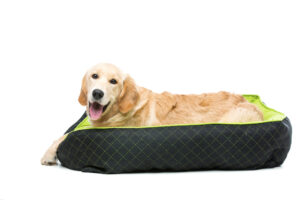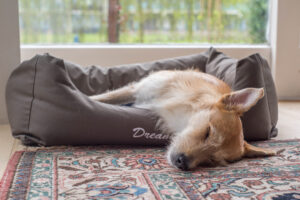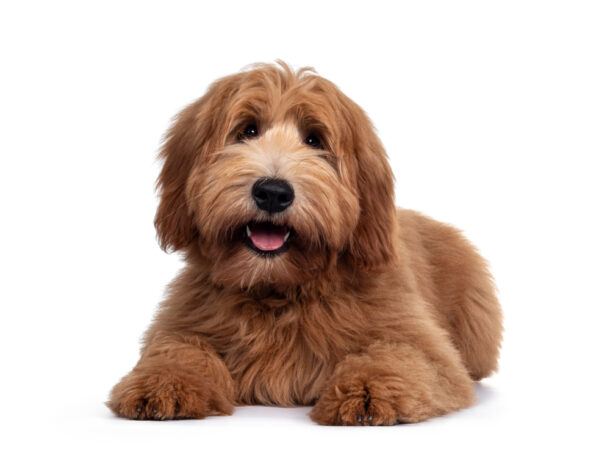Choose the Best Dog Bed Size
LifeWithMyDogs is supported by our audience. When you purchase through one of our links, we may earn a small affiliate commission. As an Amazon Associate I earn from qualifying purchases. Your cost is not affected.
**********
Introduction to Orthopedic Dog Bed Sizes
Orthopedic dog bed sizes may seem like a mundane topic. But knowing how to choose the best dog bed size for your furry friend is crucial for their comfort, well-being, and overall health. With the vast array of dog bed sizes on the market, it can be overwhelming to determine the ideal size for your pooch. This article will provide expert guidance on orthopedic dog bed sizes, including the importance of choosing the right size, factors to consider, and how to measure your dog for the perfect bed size. By the end, you’ll have all the information needed to make an educated decision on what size dog bed is best for your canine companion.

Orthopedic dog beds are designed to provide optimal support and comfort for dogs, particularly those with joint and muscle issues or elderly dogs with arthritis. These beds contain memory foam or other types of supportive cushioning that contour to the dog’s body, reducing pressure points and providing relief from pain and discomfort. With so many dog bed sizes available, it is essential to choose the correct size to ensure your dog receives the full benefits of an orthopedic bed.
Understanding the importance of dog bed sizes and knowing how to choose the right one can make a significant difference in your dog’s quality of life. Keep reading to learn more about the factors to consider when selecting the perfect bed size for your pooch.
 Importance of Choosing the Right Dog Bed Size
Importance of Choosing the Right Dog Bed Size
Selecting the appropriate dog bed size is crucial for several reasons. First and foremost, the right-sized bed provides a sense of security and comfort for your dog. Dogs are den animals. They need a place where they feel secure and can retreat to when they need rest or privacy. A bed that is too small will not provide the necessary space for your dog to stretch out and relax, while a bed that is too large may not offer the cozy feeling they desire.
Another reason why dog bed sizes matter is that the proper size will provide adequate support for your dog’s body. Orthopedic beds are designed to alleviate pressure on joints and muscles, but if the bed is too small, your dog will not receive the full benefits of supportive cushioning. On the other hand, a bed that is too large may not provide enough support in the right places, leading to discomfort and potential health issues.
Lastly, choosing the right dog bed size can also have an impact on the overall aesthetics and functionality of your living space. A bed that is too large may take up too much room and become an obstacle in your home, while a bed that is too small may not provide enough space for your dog to feel comfortable and secure.

Factors to Consider When Determining Dog Bed Size
Several factors come into play when determining the ideal dog bed size for your furry companion. These factors include:
- Your Dog’s Size: This is the most obvious factor to consider when determining the appropriate dog bed size. The bed should be large enough for your dog to stretch out comfortably without any part of their body hanging off the edge. To determine the proper bed size, you’ll need to measure your dog’s length and width, as well as consider their weight and height.
- Sleeping Style: How your dog sleeps also plays a role in selecting the right dog bed size. For dogs that like to curl up in a ball, a smaller bed with raised edges might be suitable. However, dogs that stretch out or sprawl when they sleep will require a larger bed with ample room to accommodate their preferred sleeping position.
- Age and Health: Older dogs and those with joint or muscle issues may require a larger bed with additional support. Consider an orthopedic bed with memory foam or other supportive cushioning materials to help alleviate any discomfort and provide optimal support.
- Available Space: The size of your living space is another factor to consider when choosing a dog bed. Ensure the bed you select will fit comfortably in the designated area without causing any obstructions or taking up too much space.
Common Dog Bed Size Categories
Dog bed sizes typically fall into one of the following categories:
- Small: Small dog bed sizes are best suited for dogs weighing up to 25 pounds. These beds usually measure around 18-24 inches in length and are ideal for breeds like Chihuahuas, Dachshunds, and Pugs.
- Medium: Medium-sized dog beds are designed for dogs weighing between 25-50 pounds. These beds typically measure between 24-36 inches in length and are suitable for breeds like Beagles, Border Collies, and Cocker Spaniels.
- Large: Large dog bed sizes are appropriate for dogs weighing between 50-100 pounds. These beds generally measure between 36-48 inches in length and are suitable for breeds like Golden Retrievers, Labrador Retrievers, and Boxers.
- Extra-Large: Extra-large dog beds are designed for dogs weighing over 100 pounds. These beds usually measure 48 inches or more in length and are ideal for breeds like Great Danes, Mastiffs, and Saint Bernards.
Keep in mind that these size categories are general guidelines and may vary slightly between different brands and bed styles.
How to Measure Your Dog for the Perfect Bed Size
To find the ideal dog bed size for your pooch, start by measuring their length and width. To measure length, have your dog stand up straight and measure from the tip of their nose to the base of their tail. For width, measure the distance from one shoulder blade to the other. Be sure to add a few inches to these measurements to account for your dog’s preferred sleeping position and any additional room they may need to stretch out comfortably.
Once you have these measurements, consider your dog’s weight and height, as well as any specific health concerns or needs they may have. With this information in hand, you can confidently select the appropriate dog bed size for your furry friend.

Expert Tips: What Size Dog Bed Do I Need?
When determining what size dog bed is needed, consider the following expert tips:
- Opt for a slightly larger bed: It is always better to choose a bed that is slightly larger than your dog’s measurements. This will ensure they have enough space to stretch out and move around comfortably.
- Consider your dog’s growth: If you have a puppy or a young dog that is still growing, be sure to select a bed size that will accommodate their expected adult size.
- Choose a bed with a washable cover: Accidents happen, and having a washable cover will make it much easier to keep your dog’s bed clean and hygienic.
Customizing Dog Bed Sizes for Unique Needs
Some dogs may have unique needs that require a customized dog bed size. For example, dogs with mobility issues or disabilities may need a bed with a lower profile for easier access, or a bed with additional support and cushioning. In these cases, it is essential to consult with your veterinarian to determine the optimal bed size and features for your dog’s specific needs.
Additionally, if you have multiple dogs that like to share a bed, you’ll need to take their combined measurements and weight into account when selecting the appropriate bed size.
How Big Should a Dog Bed Be for Different Dog Breeds
While the previously mentioned dog bed size categories provide a general guideline for selecting the appropriate bed size, it can be helpful to consider the specific breed of your dog as well. Here are some examples of recommended dog bed sizes for various breeds. Please remember that these are averages. If your dog is large for his breed, you may need to adjust upward.
- Small Breeds: Chihuahuas, Dachshunds, Pugs, and Yorkshire Terriers typically require a small-sized bed, approximately 18-24 inches in length.
- Medium Breeds: Beagles, Border Collies, Cocker Spaniels, and Shetland Sheepdogs generally need a medium-sized bed, approximately 24-36 inches in length.
- Large Breeds: Golden Retrievers, Labrador Retrievers, Boxers, and German Shepherds typically need a large-sized bed, approximately 36-48 inches in length.
- Extra-Large Breeds: Great Danes, Mastiffs, Saint Bernards, and Irish Wolfhounds generally require an extra-large bed, measuring 48 inches or more in length.
Again, these recommendations are general guidelines, and it is essential to measure your dog and consider their unique needs when selecting the ideal bed size. This chart by Purina offers general guideline help for dog sizes.
Top Orthopedic Dog Bed Brands and Their Size Offerings
There are several reputable orthopedic dog bed brands on the market, each with its unique size offerings. Some of the top brands include:
- Big Barker: Known for their high-quality orthopedic dog beds, Big Barker offers beds in large, extra-large, and giant sizes to accommodate larger breeds. See our recommendations for Big Barker Beds here.
- PetFusion: This brand offers orthopedic dog beds in various sizes, ranging from small to extra-large, making them suitable for a wide range of breeds. See our recommendations for PetFusion beds here.
- BedSure: BedSure, a popular pet brand, offers a variety of pet beds, including orthopedic dog beds. Sizes range from small to medium, large, and extra large. See our recommendations for BedSure beds here.
- The Dog’s Bed: With a focus on orthopedic support and comfort, BuddyRest offers dog beds in multiple sizes, from small to extra-large. See our recommendation for The Dog’s Bed Orthopedic Beds here.
Before making a purchase, it is essential to research each brand’s specific size offerings and compare them to your dog’s measurements and needs.
Ensuring Your Dog’s Comfort and Wellbeing with the Ideal Bed
Selecting the ideal dog bed size for your furry friend is essential for their comfort, well-being, and overall health. By considering factors such as your dog’s size, sleeping style, age, and health, you can confidently choose the perfect bed size to meet their needs. Don’t forget to measure your dog and consult expert advice to ensure you’re making the best decision for your canine companion.
With a properly sized orthopedic dog bed, your pooch can enjoy the restorative sleep they deserve, leading to a happier, healthier life.









